| |
|
|
| |
Fish prone.
Fri 16th September, 2011
|
|
|
|
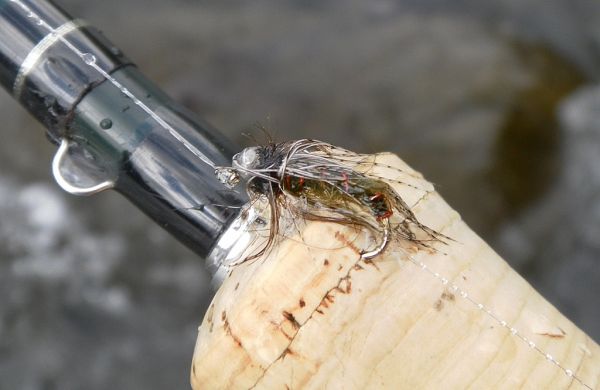 The much needed rain finally arrived but it was no where near enough and only raised the level of the Tongariro to just over 28 cumecs. However this weekend we have the first of the recreational releases for a while. On Saturday from the Poutu intake between 9am to 3pm and again on Sunday from the Rangipo intake between 8am to 4pm. The nuisance south westerly has been with us most days which always puts a few off and may go some way to explain the unusual lack of anglers earlier in the week. The much needed rain finally arrived but it was no where near enough and only raised the level of the Tongariro to just over 28 cumecs. However this weekend we have the first of the recreational releases for a while. On Saturday from the Poutu intake between 9am to 3pm and again on Sunday from the Rangipo intake between 8am to 4pm. The nuisance south westerly has been with us most days which always puts a few off and may go some way to explain the unusual lack of anglers earlier in the week.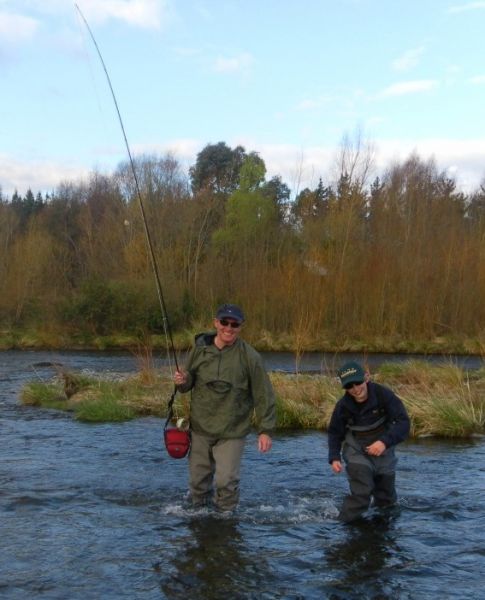 Even the Trolls Pool wasn't quite as crowded as it has been but of course there's also some sort of Rugby Tournament taking place. Even the Trolls Pool wasn't quite as crowded as it has been but of course there's also some sort of Rugby Tournament taking place.
I guess many will be glued to the box watching Wales and the AB's as they progress to their epic meeting in the Welsh-All Blacks final. Just before all this I had an entertaining afternoon with Peter and son Max from Australia. Peter is a doctor and was spending six days in New Zealand as a birthday treat for Max who was soon to be thirteen. "Unlucky for some" proved to be right because despite Dad hooking up to a couple of strong rainbows he lost them both when they took off like steam trains downriver. To add insult to injury Max jumped into Dad's hot-spot and landed the little jack above which swam off happily even though it had a bloody nose. There was obviously a little bit of rivalry going on because while Peter was telling me later in the day how accident prone his son was... Max piped up that he was "also fish prone" which shut Dad up and had us all chuckling...enjoy the rest of your stay guys. You meet some nice people while on the river. The other day I shared a pool with Steve Ogg from Masterton who was already fishing the tail when I first arrived. We both moved through, fishing and taking a few steps as we went up and down the stretch. Every so often we had a natter and he even offered me a cup of tea...no hassle...and no problems... just as it should be. Eventually I moved on, unaware that I had dropped one of my small fly boxes. A couple of days later the phone rang, it was Steve. He had taken the trouble to track me down and after taking my address the flies arrived safe and sound the next day...thanks mate.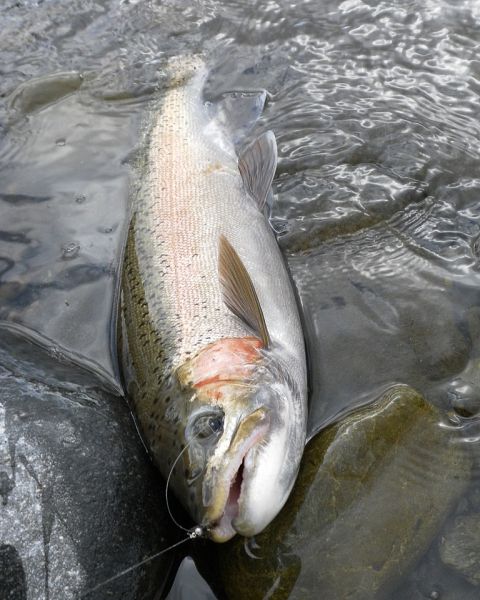
For the last couple of years roughly fifty per cent of the fish I catch on the Tongariro have been taken on one particular fly...a caddis emerger pattern available from Riverway General Store. There is a marked increase in that percentage when talking browns. Angling legends like the late Gary LaFontaine have given the rest of us a window into what happens below the surface of a river or stream. Gary passed away age 56 years old in 2004 after a long battle with Lou Gehrig's disease.
He often used scuba diving equipment to study aquatic insects and the trouts interaction with them. His articles, books and observations surrounding the life cycle of caddis are particularly well known. From his own underwater research and earlier studies by other writers, he knew that caddis produced air bubbles both to aid emergence and in some species when egg-laying. In the early 1970's a new material called antron used in carpet manufacture was developed and he was the first fly-tier to try it in his fly patterns.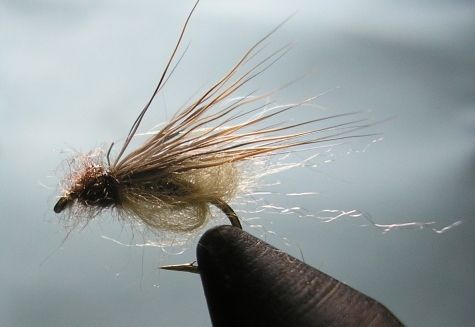
He added combed antron to replicate the effect of gas bubbles surrounding the ascending insect in his famous Emergent Sparkle and Deep Sparkle Pupa series of caddis flies. He noted that during a caddis hatch there were three distinct stages which an angler could imitate, hopefully fooling more fish. I find the first stage especially interesting because it illustrates why the use of an emerger pattern in the dry and dropper rig is such a consistent fish catcher. In the cooler months I tend to fish this method in slow to medium flow water between 18 inches and four feet deep. This is because the flies that work best with this rig are not that heavy, in deeper faster water they'd be suspended well above most of the fish that are favoring the bottom on their spawning runs. The inside seams at the heads of pools or shallower runs are ideal places. Remember too that most of the prey items that feeding fish are taking will also be very near the bottom in winter.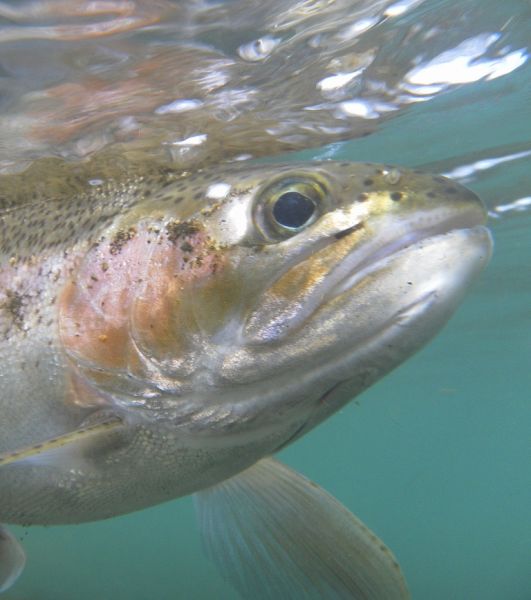 Any insect hatches that occur will be short-lived affairs so trout are still not conditioned to "look up" for their food. As the temperatures warm up and insect activity increases the abundance of hatching caddis and mayfly alters the trouts feeding habits. Now there is a plentiful supply of ascending nymphs and fish can be caught at all depths. In a good cicada year the cicada indicator fly will also be an added attraction and makes for some exciting surface action. In his article "Anticipating a caddis hatch" he observed that hours before the main event the first of the emerging caddis flies begin to appear. Any insect hatches that occur will be short-lived affairs so trout are still not conditioned to "look up" for their food. As the temperatures warm up and insect activity increases the abundance of hatching caddis and mayfly alters the trouts feeding habits. Now there is a plentiful supply of ascending nymphs and fish can be caught at all depths. In a good cicada year the cicada indicator fly will also be an added attraction and makes for some exciting surface action. In his article "Anticipating a caddis hatch" he observed that hours before the main event the first of the emerging caddis flies begin to appear.
These often make it safely to the surface because the fish aren't yet tuned into them. As the hatch continues and slowly begins to build the fish start to switch onto this growing food supply. Even though the trout have began feeding on emergents they are still reluctant to use up energy and take the insect at the surface...for good reason. As Gary explains the emerging caddis are fully formed adults inside a thin pupal sheath. But before they begin swimming to the surface they generate air bubbles within the transparent skin to help their ascent. This takes a little time and the delay in their upward journey means there is a steady supply of easy prey drifting near the bottom. Trout will happily mop these up until the main hatch begins in earnest. This is why I believe the long dry and dropper rig using an emerging caddis pattern works so well all year round.
In shallower water it's the perfect way to imitate this early part of a caddis hatch and in deeper water during the more prolific hatches of summer the fish mistake it for the ascending emerger. When used in the right circumstances it will consistently catch fish when takes on more conventional Tongariro methods have dried up. Its also one of the reasons I always carry two rods. Having one set up with an indicator and the other the dry and dropper means I can instantly adapt to changing conditions and swop methods. By thinking outside the square there are also things you can do to "tweak" the set up...sorry guys that's my little secret for now. 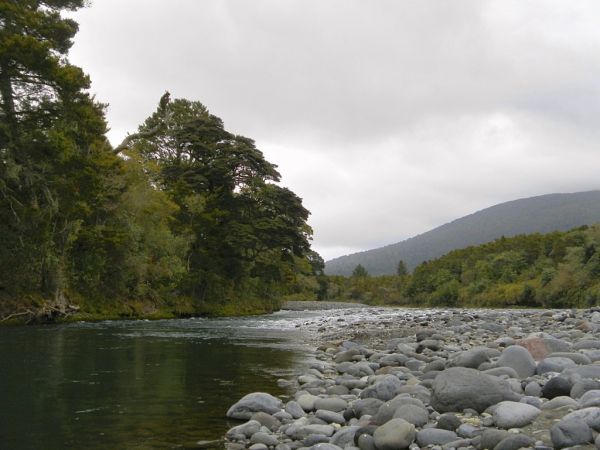 Fish have been moving all week and are spread throughout the river. Some of the upper river pools are holding plenty of fish but with far more important distractions are generally refusing to play ball. The best results look to be coming from the middle reaches down with lots of happy fisho's around the town pools and good reports from those that ventured a bit further downriver. For weeks there have been lots of stories of anglers losing fish and a couple of times lately I've caught fish with someone else's fly stuck in its mouth...like the jack below. Although it previously took a globug it must be getting fed up with them because this time it went for the "never fail" caddis emerger. Fish have been moving all week and are spread throughout the river. Some of the upper river pools are holding plenty of fish but with far more important distractions are generally refusing to play ball. The best results look to be coming from the middle reaches down with lots of happy fisho's around the town pools and good reports from those that ventured a bit further downriver. For weeks there have been lots of stories of anglers losing fish and a couple of times lately I've caught fish with someone else's fly stuck in its mouth...like the jack below. Although it previously took a globug it must be getting fed up with them because this time it went for the "never fail" caddis emerger.
Looks like unsettled weather for the next few days with periods of heavy showers and gusty winds. This will no doubt keep the fish coming and the weekend recreational releases will put some color and a lot more besides into the river. Wet-liners targetting the edges will score well and the early part of next week especially, should see plenty of action for everyone...see you out there guys.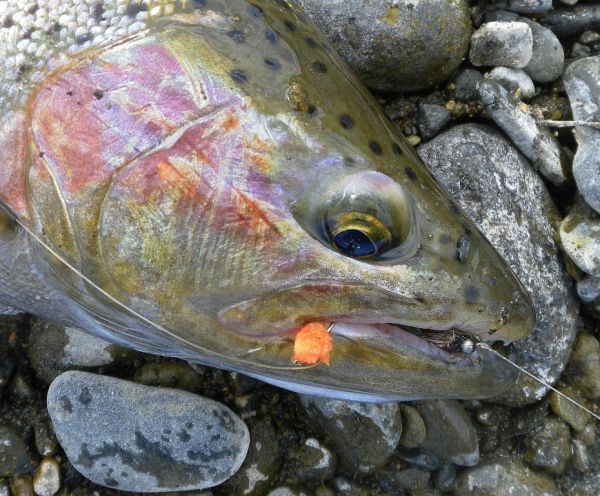
Be lucky
Mike |
|
|
| Back to Top |
|
|
|
|
|
|
|